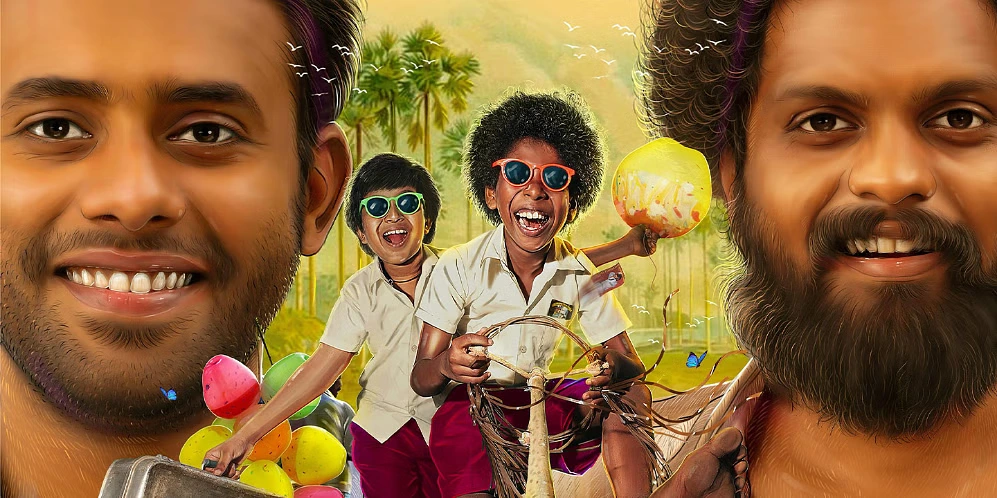At first, ‘Pallotty’ may look like a simple nostalgia exercise. But slowly, the film becomes deeper. It doesn’t milk situations for emotion and sentimentality.
Jithin Raj had the story idea for Pallotty 90’s Kids and he has directed it beautifully from writer Deepak Vasan’s screenplay. Once again, the separation of writing and directing duties pays off rich dividends for Malayalam cinema. Let me begin with what does not work, because that’s very little. The segue into the 1990s-era story from the modern day could have been more inventive, and the last few scenes needed a little more time to breathe. The message-y closure to the subplot involving Saiju Kurup, the big reunion at the ending – these needed as much detailing as the rest of this wonderful movie. And yet, I wept. I mean, I didn’t just mist up. I actually had tears pouring down. That is the power of the gently accumulative storytelling in this trip down memory lane, this ode to selfless friendship.
The opening credits appear over images that look like storybooks for children – not the super-slick images from today’s children’s books but the hand-drawn pictures we saw in Champak or Chandamama. Though I am not a 90s kid, I could relate easily to this story because this is still the age of a single television channel, Doordarshan – and friendship, of course, is timeless. The utterly brilliant Davinchi Santhosh plays Kannan, whose father is no more and whose mother supports the family. Kannan’s neighbour in this little village is the relatively well-off Unni (Neeraj Krishna, who’s also terrific, especially in the different ways he keeps addressing his “Kannan Chetta”). If you wish, you could read an element of the Krishna-Sudama story into this friendship, especially given the scene involving flattened rice. But even otherwise, the two actors use their situations and lines to create a superb bond. At first, Pallotty may look like a simple nostalgia exercise, filled with Camlin geometry boxes and Shaktimaan and Sachin Tendulkar and The Undertaker and knowing how to fix the rubber chappal strap that has snapped free. But slowly, even as we delight in these memories, the film becomes deeper.

The main reason Pallotty works so well is that it doesn’t milk situations for emotion and sentimentality. Despite composer Manikandan Ayyappa’s occasionally underlining score, we get the sense of casualness, that things are just happening. We see Kannan walking to school and we see another boy on a bicycle, and the class difference is instantly apparent. But the point is not hammered home. This boy may be a bit of a jerk, like all kids are, but he is not an “evil rich kid” – and later, when he wins a crucial event, he does not gloat. The focus stays on what’s important: the Unni-Kannan friendship. Kannan’s ability to win running races, his new rubber chappals, chewing gum, a science-class demo of the digestive system, Kannan’s pants that are too loose, the grown-up Unni’s claim that the best unniappam-s come from a particular place. All of these get echo moments that work wonderfully.
Pallotty is beautifully paced and it’s never boring. (I mention this because, sometimes, an over-reliance on nostalgia can get tiresome.) The film is also hilarious, and all the more so because the things we find amusing are life-or-death situations to these children. For instance, can kissing result in babies? This thought gets a lovely echo in a sweet and funny “suicide note”. And we recall that a character, early on, died by suicide. Life keeps circling around – and keeps going in circles – around Kannan and Unni. Even the friendship between the characters played by Saiju Kurup and Sudhi Koppa can be seen as grown-up versions of Kannan and Unni. We learn that the Saiju Kurup character’s father was a playwright, and a resentful story about childhood is presented like theatre. But recalling the innocence of childhood is the nudge these men need to rid themselves of the grudges that have kept well into adulthood.
Kannan is so good and pure that he reminded me of the Karthi character from Meiyazhagan. Even when he sees a classmate being driven to school by her father, on a scooter, he is convinced that walking is better because he can pluck mangoes along the way. This is the same spirit he shows when he is unhappy about his dinner. He may complain to his mother, but he puts on a happy face when Unni comes by. Sharon Sreenivas, the cinematographer, shoots most of the film with a floating camera that gives the impression that these shots are not “composed”, that they are as free as the lives of these children. But again and again, we marvel at the writing. Early on, we see Kannan’s lack of confidence in science class, when he does not present his project. Later, Unni (through a letter) resolves to tackle this very aspect: this lack of confidence.
This close knitting of themes is why Pallotty earns the right to our laughs and tears. This is not a manipulative movie that coasts along on easy nostalgia. It uses memories to tell a story that tells us that there are people who love us more than we love ourselves. And what is the inability to love oneself? It is, after all, a kind of… lack of confidence, the kind that Kannan has. After all this exquisite, unhurried writing, the last stretch, as I said, seems too sudden. Given that the film runs just a little over 95 minutes, surely the same depth could have been given to the ending. But again, I am not complaining. Kannan may be a very clever boy, an inventor, but this is not the kind of fantasy film that makes him leave his village and end up at NASA or something. There is a simplicity, an honesty, a refreshing real-ness about the craft in Pallotty. I laughed. I cried. I felt good.


